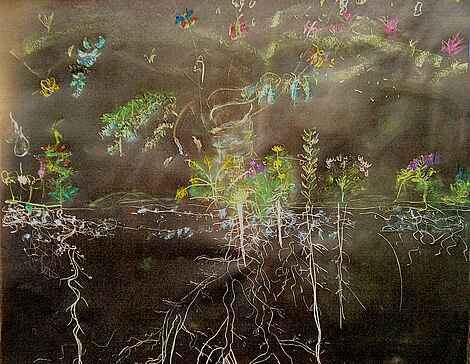Ruth Richter
In terms of the benefits yielded, their cultivation ensures high values in yield no.1, the promotion and regeneration of soil life and thus of the earth. According to grain breeder Peter Kunz, yield no.2 is what feeds animals, whether dairy cows, chickens, or microbes. Yield no.3 concerns human nutrition. We learned all this in the annual weekly course of further training for breeders, which took place in January 2023 in Emmental, Switzerland. The main topic was legumes, a plant family that makes up one seventh of all cultivated plants on earth and specializes in collaboration.
This collaboration begins with the close interaction between the individual plant and soil bacteria of the genus Rhizobium. Once the bacteria have found the plant root, they penetrate the root hair and give the plant the impulse to change its growth behavior. The root cells then form the well-known nodules, in which some of the bacteria change fundamentally, to gain an ability that they do not have when living freely in the soil: they can fix nitrogen from the air and make it available to the plant. When both participants change in a mutual process, this is commonly referred to as symbiosis – it is an existential cooperation.
This symbiosis is part of a cycle that must be considered on a global scale: the nitrogen cycle. Three quarters of our air is elemental nitrogen (N2). However, it cannot be used in this form by plants and animals, which need it to build living matter. Only certain strains of bacteria can make it available. Conversely, bacteria also reduce ammonium to nitrate and then into N2.
Through their symbiosis with bacteria, legumes therefore play an exceptional role in the cultivation of crops for humans. But they also cooperate with other plants by using their long taproots to draw water from deep regions below the surface of the earth. In desert areas of Ethiopia, for example, agriculture is only possible between rows of legume trees, which provide water from the depths, shade and valuable fodder with their leaves. These plants are therefore of far-reaching importance for agriculture in regions that are becoming increasingly arid due to climate change. We can call them the plants of the future – an encouraging statement for all growers in the group who cultivate peas, beans or lentils.
Or via Bank Transfer:
| CHF | EUR | |
| Allgemeine Anthroposophische Gesellschaft Postfach, 4143 Dornach/Schweiz Raiffeisenbank Dornach, CH–4143 Dornach BIC: RAIFCH22 IBAN: CH54 8080 8001 1975 4658 2 ⇨ Payment Purpose: KST 1124 | Allgemeine Anthroposophische Gesellschaft Postfach, 4143 Dornach/Schweiz GLS Gemeinschaftsbank eG, DE-44708 Bochum BIC: GENODEM1GLS IBAN: DE53 4306 0967 0000 9881 00 ⇨ Payment Purpose: KST 1124 |

